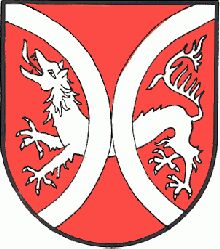Gschaid bei Birkfeld: Difference between revisions
Jump to navigation
Jump to search
Knorrepoes (talk | contribs) m (Text replace - "Österreich" />" />" to "Österreich" />") |
Knorrepoes (talk | contribs) m (Text replace - "[[Literature" to "{{media}} [[Literature") |
||
| Line 16: | Line 16: | ||
Gschaid is an old word meaning a pass through a mountain divide (scheiden means "to divide"). There are several such "Gschaids" in Styria. In historical times, important streets crossed the Gschaid, linking the mining region, Eastern Styria and (ultimately) Hungary. The streets were put into the arms along with a wolf, taken from a medieval squire's coat of arms. | Gschaid is an old word meaning a pass through a mountain divide (scheiden means "to divide"). There are several such "Gschaids" in Styria. In historical times, important streets crossed the Gschaid, linking the mining region, Eastern Styria and (ultimately) Hungary. The streets were put into the arms along with a wolf, taken from a medieval squire's coat of arms. | ||
{{media}} | |||
[[Literature]] : Image provided by Karl Palfrader (k.palfrader@aon.at), MStLA 41 (1991), p. 32 | [[Literature]] : Image provided by Karl Palfrader (k.palfrader@aon.at), MStLA 41 (1991), p. 32 | ||
Revision as of 22:18, 8 July 2014
| Heraldry of the World Civic heraldry of Austria - Österreichische Gemeindewappen |
GSCHAID BEI BIRKFELD
State : Steiermark
District : Weiz
Origin/meaning
The arms were granted on July 2nd, 1990.
Gschaid is an old word meaning a pass through a mountain divide (scheiden means "to divide"). There are several such "Gschaids" in Styria. In historical times, important streets crossed the Gschaid, linking the mining region, Eastern Styria and (ultimately) Hungary. The streets were put into the arms along with a wolf, taken from a medieval squire's coat of arms.
Contact and Support
Partners:
Your logo here ?
Contact us
© since 1995, Heraldry of the World, Ralf Hartemink 
Index of the site
Literature : Image provided by Karl Palfrader (k.palfrader@aon.at), MStLA 41 (1991), p. 32











